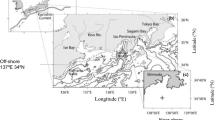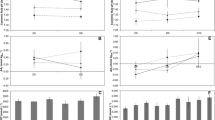Abstract
Organic alkalinity is a poorly understood component of total titration alkalinity in aquatic environments. Using a numerical method, the effects of organic acid (HOA) and its conjugate base (OA−) on seawater carbonate chemistry and buffer behaviors, as well as those in a hypothetical estuarine mixing zone, are explored under both closed- and open-system conditions. The simulation results show that HOA addition leads to pCO2 increase and pH decrease in a closed system when total dissolved inorganic carbon (DIC) remains the same. If opened to the atmosphere (pCO2 = 400 µatm), CO2 degassing and re-equilibration would cause depressed pH compared to the unperturbed seawater, but the seawater buffer to pH change \(\left( {\beta _{{{\text{DIC}}}} \, = \left( {\frac{{\partial \ln \left( {\left[ {{\text{H}}^{ + } } \right]} \right)}}{{\partial {\text{DIC}}}}} \right)^{{ - 1}} } \right)\) indicates that weaker organic acid (i.e., higher pKa) results in higher buffer capacity (greater βDIC) than the unperturbed seawater. In comparison, OA− (with accompanying cations) in the form of net alkalinity addition leads to pCO2 decrease in a closed system. After re-equilibrating with the atmosphere, the resulting perturbed seawater has higher pH and βDIC than the unperturbed seawater. If river water has organic alkalinity, pH in the estuarine mixing zone is always lower than those caused by a mixing between organic alkalinity-free river (at constant total alkalinity) and ocean waters, regardless of the pKa values. On the other hand, organic alkalinity with higher pKa provides slightly greater βDIC in the mixing zone, and that with lower pKa either results in large CO2 oversaturation (closed system) or reduced βDIC (in mid to high salinity in the closed system or the entire mixing zone in the open system). Finally, despite the various effects on seawater buffer through either HOA or OA− addition, destruction of organic molecules including organic alkalinity via biogeochemical reactions should result in a net CO2 loss from seawater. Nevertheless, the significance of this organic alkalinity, especially that comes from organic acids that are not accounted for under the currently recognized “zero proton level” (Dickson in Deep Sea Res 28:609–623, 1981), remains unknown thus a potentially interesting and relevant research topic in studying oceanic alkalinity cycle.







Similar content being viewed by others
References
Abril G et al (2015) Technical note: large overestimation of pCO2 calculated from pH and alkalinity in acidic, organic-rich freshwaters. Biogeosciences 12:67–78
Amon RMW, Benner R (1996) Photochemical and microbial consumption of dissolved organic carbon and dissolved oxygen in the Amazon River system. Geochim Costmochim Acta 60:1783–1792
Ben-Yaakov S (1973) pH buffering of pore water of recent anoxic marine sediments. Limnol Oceanogr 18:86–94
Borges AV, Schiettecatte LS, Abril G, Delille B, Gazeau F (2006) Carbon dioxide in European coastal waters. Estuar Coast Shelf Sci 70:375–387
Boudreau BP, Canfield DE (1993) A comparison of closed- and open-system models for porewater pH and calcite-saturation state. Geochim Costmochim Acta 57:317–334
Butman D, Raymond PA (2011) Significant efflux of carbon dioxide from streams and rivers in the United States. Nat Geosci 4:839–842
Cai W-J, Yongchen W, Hodson RE (1998) Acid-base properties of dissolved organic matter in the estuarine waters of Georgia, USA. Geochim Costmochim Acta 62:473–483
Dickson AG (1981) An exact definition of total alkalinity, and a procedure for the estimation of alkalinity and total inorganic carbon from titration data. Deep Sea Res 28:609–623
Dickson AG (1992) The development of the alkalinity concept in marine chemistry. Mar Chem 40:49–63
Dickson AG, Millero FJ (1987) A comparison of the equilibrium constants for the dissociation of carbonic acid in seawater media. Deep Sea Res 34:1733–1743
Dickson AG, Wesolowski DJ, Palmer DA, Mesmer RE (1990) Dissociation constant of bisulfate ion in aqueous sodium chloride solutions to 250.degree.C. J Phys Chem 94:7978–7985
Dickson AG, Sabine CL, Christian JR (eds) (2007) Guide to best practices for ocean CO2 measurements. PICES Special Publication 3, 191 pp. https://www.nodc.noaa.gov/ocads/oceans/Handbook_2007.html
Egleston ES, Sabine CL, Morel FMM (2010) Revelle revisited: buffer factors that quantify the response of ocean chemistry to changes in DIC and alkalinity. Glob Biogeochem Cycle. https://doi.org/10.1029/2008GB003407
Fichot CG, Benner R (2014) The fate of terrigenous dissolved organic carbon in a river-influenced ocean margin. Glob Biogeochem Cycle 28:300–318
Fong MB, Dickson AG (2019) Insights from GO-SHIP hydrography data into the thermodynamic consistency of CO2 system measurements in seawater. Mar Chem 211:52–63
Frankignoulle M (1994) A complete set of buffer factors for acid/base CO2 system in seawater. J Mar Syst 5:111–118
Hagens M, Middelburg JJ (2016) Generalised expressions for the response of pH to changes in ocean chemistry. Geochim Costmochim Acta 187:334–349
Hagens M, Hunter KA, Liss PS, Middelburg JJ (2014) Biogeochemical context impacts seawater pH changes resulting from atmospheric sulfur and nitrogen deposition. Geophys Res Lett 41:935–941
Hammer K, Schneider B, Kuliński K, Schulz-Bull DE (2017) Acid-base properties of Baltic Sea dissolved organic matter. J Mar Syst 173:114–121
Hernández-Ayon JM, Zirino A, Dickson AG, Camiro-Vargas T, Valenzuela-Espinoza E (2007) Estimating the contribution of organic bases from microalgae to the titration alkalinity in coastal seawaters. Limnol Oceanogr Methods 5:225–232
Hofmann AF, Middelburg JJ, Soetaert K, Wolf-Gladrow DA, Meysman FJR (2010) Proton cycling, buffering, and reaction stoichiometry in natural waters. Mar Chem 121:246–255
Hofmann GE et al (2011) High-frequency dynamics of ocean pH: a multi-ecosystem comparison. PLoS ONE 6:e28983
Hu X, Cai W-J (2011) An assessment of ocean margin anaerobic processes on oceanic alkalinity budget. Glob Biogeochem Cycle. https://doi.org/10.1029/2010GB003859
Hu X, Cai W-J (2013) Estuarine acidification and minimum buffer zone—a conceptual study. Geophys Res Lett 40:5176–5181
Hunt CW, Salisbury JE, Vandemark D (2011) Contribution of non-carbonate anions to river alkalinity and overestimation of pCO2. Biogeosciences 8:3069–3076
Jiang L-Q, Cai W-J, Wang Y (2008) A comparative study of carbon dioxide degassing in river- and marine-dominated estuaries. Limnol Oceanogr 53:2603–2615
Jourabchi P, Van Cappellen P, Regnier P (2005) Quantitative interpretation of pH distributions in aquatic sediments: a reaction-transport modeling approach. Am J Sci 305:919–956
Kim H-C, Lee K (2009) Significant contribution of dissolved organic matter to seawater alkalinity. Geophys Res Lett 36:L20603. https://doi.org/10.21029/22009GL040271
Kim H-C, Lee K, Choi W (2006) Contribution of phytoplankton and bacterial cells to the measured alkalinity of seawater. Limnol Oceanogr 51:331–338
Ko YH, Lee K, Eom KH, Han I-S (2016) Organic alkalinity produced by phytoplankton and its effect on the computation of ocean carbon parameters. Limnol Oceanogr 61:1462–1471
Kuliński K, Schneider B, Hammer K, Machulik U, Schulz-Bull D (2014) The influence of dissolved organic matter on the acid–base system of the Baltic Sea. J Mar Syst 132:106–115
Lukawska-Matuszewska K (2016) Contribution of non-carbonate inorganic and organic alkalinity to total measured alkalinity in pore waters in marine sediments (Gulf of Gdansk, S-E Baltic Sea). Mar Chem 186:211–220
Lundegard PD, Land LS (1989) Carbonate equilibria and pH buffering by organic acids—response to changes in pCO2. Chem Geol 74:277–287
Mehrbach C, Culberson CH, Hawley JE, Pytkowicz RM (1973) Measurement of the apparent dissociation constants of carbonic acid in seawater at atmospheric pressure. Limnol Oceanogr 18:897–907
Millero FJ (1979) The thermodynamics of the carbonate system in seawater. Geochim Costmochim Acta 43:1651–1661
Millero FJ (1983) The estimation of the pK∗HA of acids in seawater using the Pitzer equations. Geochim Costmochim Acta 47:2121–2129
Millero FJ (2001) Physical chemistry of natural waters. Wiley-Interscience series in geochemistry. Wiley-Interscience, New York
Muller FLL, Bleie B (2008) Estimating the organic acid contribution to coastal seawater alkalinity by potentiometric titrations in a closed cell. Anal Chim Acta 619:183–191
Nydahl AC, Wallin MB, Weyhenmeyer GA (2017) No long-term trends in pCO2 despite increasing organic carbon concentrations in boreal lakes, streams, and rivers. Glob Biogeochem Cycle 31:985–995
Perdue EM, Reuter JH, Ghosal M (1980) The operational nature of acidic functional group analyses and its impact on mathematical descriptions of acid–base equilibria in humic substances. Geochim Costmochim Acta 44:1841–1851
Revelle R, Suess H (1957) Carbon dioxide exchange between atmosphere and ocean and the question of an increase of atmospheric CO2 during the past decades. Tellus 9:18–27
Ritchie JD, Perdue EM (2003) Proton-binding study of standard and reference fulvic acids, humic acids, and natural organic matter. Geochim Costmochim Acta 67:85–96
Serjeant EP, Dempsey B (1979) Ionisation constants of organic acids in aqueous solution, vol 23. Pergamon, New York
Sippo JZ, Maher DT, Tait DR, Holloway C, Santos IR (2016) Are mangroves drivers or buffers of coastal acidification? Insights from alkalinity and dissolved inorganic carbon export estimates across a latitudinal transect. Glob Biogeochem Cycle 30:753–766
Stumm W, Morgan JJ (1995) Aquatic chemistry: chemical equilibria and rates in natural waters, 3rd edn. Wiley, New York
Ulfsbo A, Kuliński K, Anderson LG, Turner DR (2015) Modelling organic alkalinity in the Baltic Sea using a Humic-Pitzer approach. Mar Chem 168:18–26
Uppström LR (1974) The boron/chlorinity ratio of deep-sea water from the Pacific Ocean. Deep-Sea Res: Oceanogr Abstr 21:161–162
van Heuven S, Pierrot SD, Rae JWB, Lewis E, Wallace DWR (2011) MATLAB program developed for CO2 system calculations. ORNL/CDIAC-105b., Carbon Dioxide Information Analysis Center, Oak Ridge National Laboratory, US DoE, Oak Ridge, TN. https://doi.org/10.1002/2014GB004868
van Schie PM, Young LY (2000) Biodegradation of phenol: mechanisms and applications. Bioremediat J 4:1–18
Wang ZA, Bienvenu DJ, Mann PJ, Hoering KA, Poulsen JR, Spencer RGM, Holmes RM (2013) Inorganic carbon speciation and fluxes in the Congo River. Geophys Res Lett 40:511–516
Wang ZA, Kroeger KD, Ganju NK, Gonneea ME, Chu SN (2016) Intertidal salt marshes as an important source of inorganic carbon to the coastal ocean. Limnol Oceanogr 61:1916–1931
Welch SA, Ullman WJ (1993) The effect of organic acids on plagioclase dissolution rates and stoichiometry. Geochim Costmochim Acta 57:2725–2736
Yang B, Byrne RH, Lindemuth M (2015) Contributions of organic alkalinity to total alkalinity in coastal waters: a spectrophotometric approach. Mar Chem 176:199–207
Yao H, Hu X (2017) Responses of carbonate system and CO2 flux to extended drought and intense flooding in a semiarid subtropical estuary. Limnol Oceanogr 62:S112–S130
Acknowledgements
This study is funded by the National Science Foundation Chemical Oceanography Program (OCE-1654232). The author wishes to thank Drs. David Burdige and Robert Byrne for their helpful comments on an earlier draft of this manuscript, and Melissa McCutcheon for her editorial help. Three reviewers and the associate editor provided critical insights on an earlier version of this manuscript, which helped to improve the quality of the work.
Author information
Authors and Affiliations
Corresponding author
Additional information
Publisher's Note
Springer Nature remains neutral with regard to jurisdictional claims in published maps and institutional affiliations.
Electronic supplementary material
Below is the link to the electronic supplementary material.
Rights and permissions
About this article
Cite this article
Hu, X. Effect of Organic Alkalinity on Seawater Buffer Capacity: A Numerical Exploration. Aquat Geochem 26, 161–178 (2020). https://doi.org/10.1007/s10498-020-09375-x
Received:
Accepted:
Published:
Issue Date:
DOI: https://doi.org/10.1007/s10498-020-09375-x




